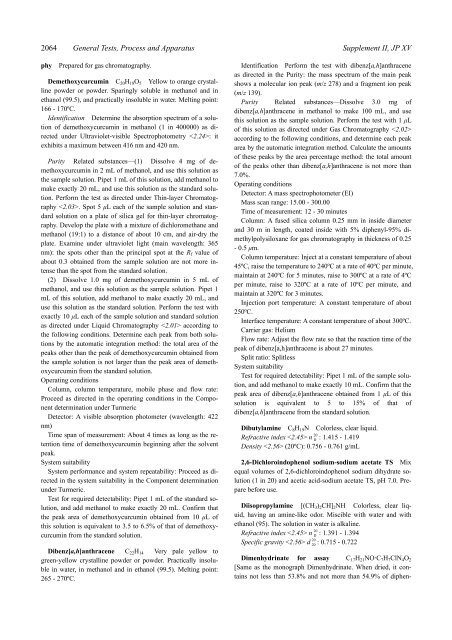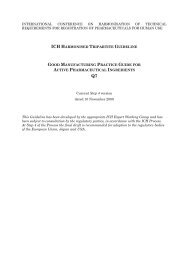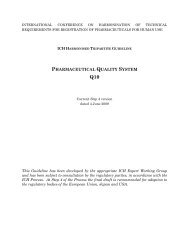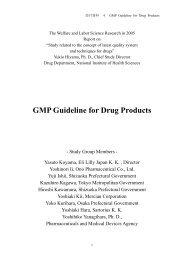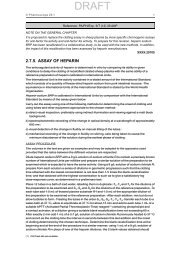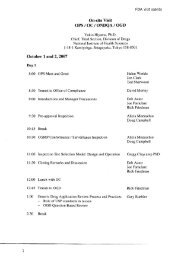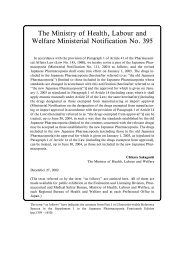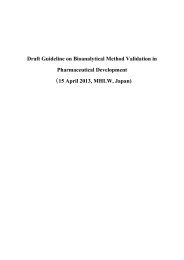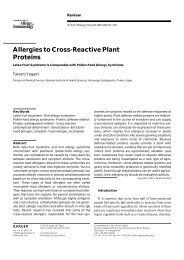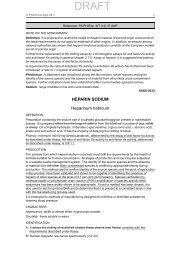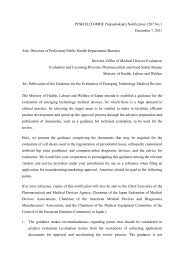supplement ii to the japanese pharmacopoeia fifteenth edition - NIHS
supplement ii to the japanese pharmacopoeia fifteenth edition - NIHS
supplement ii to the japanese pharmacopoeia fifteenth edition - NIHS
You also want an ePaper? Increase the reach of your titles
YUMPU automatically turns print PDFs into web optimized ePapers that Google loves.
2064 General Tests, Process and Apparatus Supplement II, JP XVphy Prepared for gas chroma<strong>to</strong>graphy.Demethoxycurcumin C 20 H 18 O 5 Yellow <strong>to</strong> orange crystallinepowder or powder. Sparingly soluble in methanol and inethanol (99.5), and practically insoluble in water. Melting point:166 - 170ºC.Identification Determine <strong>the</strong> absorption spectrum of a solutionof demethoxycurcumin in methanol (1 in 400000) as directedunder Ultraviolet-visible Spectropho<strong>to</strong>metry : itexhibits a maximum between 416 nm and 420 nm.Purity Related substances—(1) Dissolve 4 mg of demethoxycurcuminin 2 mL of methanol, and use this solution as<strong>the</strong> sample solution. Pipet 1 mL of this solution, add methanol <strong>to</strong>make exactly 20 mL, and use this solution as <strong>the</strong> standard solution.Perform <strong>the</strong> test as directed under Thin-layer Chroma<strong>to</strong>graphy. Spot 5 µL each of <strong>the</strong> sample solution and standardsolution on a plate of silica gel for thin-layer chroma<strong>to</strong>graphy.Develop <strong>the</strong> plate with a mixture of dichloromethane andmethanol (19:1) <strong>to</strong> a distance of about 10 cm, and air-dry <strong>the</strong>plate. Examine under ultraviolet light (main wavelength: 365nm): <strong>the</strong> spots o<strong>the</strong>r than <strong>the</strong> principal spot at <strong>the</strong> R f value ofabout 0.3 obtained from <strong>the</strong> sample solution are not more intensethan <strong>the</strong> spot from <strong>the</strong> standard solution.(2) Dissolve 1.0 mg of demethoxycurcumin in 5 mL ofmethanol, and use this solution as <strong>the</strong> sample solution. Pipet 1mL of this solution, add methanol <strong>to</strong> make exactly 20 mL, anduse this solution as <strong>the</strong> standard solution. Perform <strong>the</strong> test wi<strong>the</strong>xactly 10 µL each of <strong>the</strong> sample solution and standard solutionas directed under Liquid Chroma<strong>to</strong>graphy according <strong>to</strong><strong>the</strong> following conditions. Determine each peak from both solutionsby <strong>the</strong> au<strong>to</strong>matic integration method: <strong>the</strong> <strong>to</strong>tal area of <strong>the</strong>peaks o<strong>the</strong>r than <strong>the</strong> peak of demethoxycurcumin obtained from<strong>the</strong> sample solution is not larger than <strong>the</strong> peak area of demethoxycurcuminfrom <strong>the</strong> standard solution.Operating conditionsColumn, column temperature, mobile phase and flow rate:Proceed as directed in <strong>the</strong> operating conditions in <strong>the</strong> Componentdetermination under TurmericDetec<strong>to</strong>r: A visible absorption pho<strong>to</strong>meter (wavelength: 422nm)Time span of measurement: About 4 times as long as <strong>the</strong> retentiontime of demethoxycurcumin beginning after <strong>the</strong> solventpeak.System suitabilitySystem performance and system repeatability: Proceed as directedin <strong>the</strong> system suitability in <strong>the</strong> Component determinationunder Turmeric.Test for required detectability: Pipet 1 mL of <strong>the</strong> standard solution,and add methanol <strong>to</strong> make exactly 20 mL. Confirm that<strong>the</strong> peak area of demethoxycurcumin obtained from 10 µL ofthis solution is equivalent <strong>to</strong> 3.5 <strong>to</strong> 6.5% of that of demethoxycurcuminfrom <strong>the</strong> standard solution.Dibenz[a,h]anthracene C 22 H 14 Very pale yellow <strong>to</strong>green-yellow crystalline powder or powder. Practically insolublein water, in methanol and in ethanol (99.5). Melting point:265 - 270ºC.Identification Perform <strong>the</strong> test with dibenz[a,h]anthraceneas directed in <strong>the</strong> Purity: <strong>the</strong> mass spectrum of <strong>the</strong> main peakshows a molecular ion peak (m/z 278) and a fragment ion peak(m/z 139).Purity Related substances—Dissolve 3.0 mg ofdibenz[a,h]anthracene in methanol <strong>to</strong> make 100 mL, and usethis solution as <strong>the</strong> sample solution. Perform <strong>the</strong> test with 1 µLof this solution as directed under Gas Chroma<strong>to</strong>graphy according <strong>to</strong> <strong>the</strong> following conditions, and determine each peakarea by <strong>the</strong> au<strong>to</strong>matic integration method. Calculate <strong>the</strong> amountsof <strong>the</strong>se peaks by <strong>the</strong> area percentage method: <strong>the</strong> <strong>to</strong>tal amoun<strong>to</strong>f <strong>the</strong> peaks o<strong>the</strong>r than dibenz[a,h]anthracene is not more than7.0%.Operating conditionsDetec<strong>to</strong>r: A mass spectropho<strong>to</strong>meter (EI)Mass scan range: 15.00 - 300.00Time of measurement: 12 - 30 minutesColumn: A fused silica column 0.25 mm in inside diameterand 30 m in length, coated inside with 5% diphenyl-95% dimethylpolysiloxanefor gas chroma<strong>to</strong>graphy in thickness of 0.25- 0.5 µm.Column temperature: Inject at a constant temperature of about45ºC, raise <strong>the</strong> temperature <strong>to</strong> 240ºC at a rate of 40ºC per minute,maintain at 240ºC for 5 minutes, raise <strong>to</strong> 300ºC at a rate of 4ºCper minute, raise <strong>to</strong> 320ºC at a rate of 10ºC per minute, andmaintain at 320ºC for 3 minutes.Injection port temperature: A constant temperature of about250ºC.Interface temperature: A constant temperature of about 300ºC.Carrier gas: HeliumFlow rate: Adjust <strong>the</strong> flow rate so that <strong>the</strong> reaction time of <strong>the</strong>peak of dibenz[a,h]anthracene is about 27 minutes.Split ratio: SplitlessSystem suitabilityTest for required detectability: Pipet 1 mL of <strong>the</strong> sample solution,and add methanol <strong>to</strong> make exactly 10 mL. Confirm that <strong>the</strong>peak area of dibenz[a,h]anthracene obtained from 1 µL of thissolution is equivalent <strong>to</strong> 5 <strong>to</strong> 15% of that ofdibenz[a,h]anthracene from <strong>the</strong> standard solution.Dibutylamine C 8 H 19 N Colorless, clear liquid.Refractive index n 20D: 1.415 - 1.419Density (20ºC): 0.756 - 0.761 g/mL2,6-Dichloroindophenol sodium-sodium acetate TS Mixequal volumes of 2,6-dichloroindophenol sodium dihydrate solution(1 in 20) and acetic acid-sodium acetate TS, pH 7.0. Preparebefore use.D<strong>ii</strong>sopropylamine [(CH 3 ) 2 CH] 2 NH Colorless, clear liquid,having an amine-like odor. Miscible with water and wi<strong>the</strong>thanol (95). The solution in water is alkaline.Refractive index n 20D: 1.391 - 1.394Specific gravity d 2020: 0.715 - 0.722Dimenhydrinate for assay C 17 H 21 NO·C 7 H 7 ClN 4 O 2[Same as <strong>the</strong> monograph Dimenhydrinate. When dried, it containsnot less than 53.8% and not more than 54.9% of diphen-


